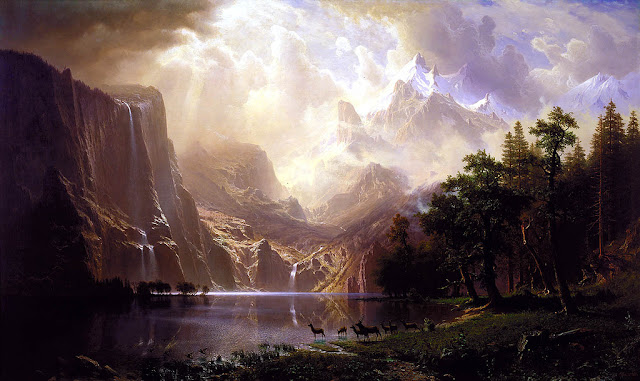Romantics interpreted his pictures as depictions of the landscapes of the inner mind, along the lines of what would later be associated with Freud and Dali.
Here (above) Martin depicts Macbeth but for some of his contemporaries he seemed also to convey the majesty and tumult of the inner mind. How, reasoned the Romantics, could man ever be happy as a slave or as the victim of a life of quiet desperation when his true mission is to heroically wander the vast inner landscape of the mind?
That sounds like an Eastern concept...did Indian philosophy affect the West in the 19th Century? I guess it did...look at Schopenhauer.
To judge from the pictures, Martin unconsciously sees man as a tragic, Wagnerian figure. We're warriors who will spit in the eyes of the gods if need be, and that's why they're interested in us.
It's odd to think that a hundred years after Martin's lifetime the pendulum would swing the other way and man would in some places be perceived as a hapless statistic, possessing only an outer life.
Here's (above) a picture that influenced Ray Harryhausen. Ray was a huge fan of Martin and Gustav Dore.
Americans will no doubt react to Martin with the feeling that they've seen that kind of statement before. Well, that's because they have. Our high style of Western painting derives from American painters like Thomas Cole, and Cole was a pupil of John Martin's, Over here Martin's grandiose style was put to the service of awe-inspiring landscape and the extreme Romantic philosophy was deleted. This adaption is a style that perfectly fits the American wilderness.
By the way, the picture above is by Bierstadt, who I assume was a pupil of Cole. As with most of the pictures in this post, it would benefit from a substantial enlargement. I wish I could have found a larger, high res version.








10 comments:
The scenery looks almost real but the color choice makes it seem unreal. I mean that as a compliment, the color is great.
The one of the man about to fall off the cliff above black oblivion is really frightening!
Nice post U.E.
The Martin paintings are quite large
The Bierstadt, et al, look tame in comparison. I guess they use the figure quite differently also. Not so much as the protagonist, as in the Martin,but more as a complementary player, if that makes sense.
Interesting comparison because the parts, so to speak, and the technique, are pretty much the same, but the results are so different. About as different as Schopenhoer(sp) and Emerson.
Among other things. the Martin paintings are quite ridiculous.
Awesome. I read a review comparing his paintings to today's epic Hollywood special effects. The writer said he wasn't too good with the human figure, but these look amazing. The one of the wilderness at the end is breathtaking. Is that Martin too or one of his American followers?
Hayden: That last one is by Bierstadt. I can't remember the title...something like "Sierra Nevadas, California." I wish I could have found a really large, high-res version of it.
Thomas: I forgot about Emerson. Probably a lot of 19th Century thinkers were influenced by Eastern philosophy. That's a time that needs to be better understood.
Scrawney: Is that guy about to fall? I thought he was climbing up. Maybe I'm wrong.
I was not familiar with Martin so thank you for this post. I do see the similarities and the attraction Harryhausen felt for Dore and Martin but wonder if the intention was different than what you perceived with some of the paintings. Perhaps, and this is just my opinion without any research on the man, Martin didn’t see humanity as tragic Wagnerian warriors, but more as rebellious people who fought against and corrupted the natural order? This would fit better with the Biblical motifs and explain the grandiose theatrical landscapes shared by Dore.
Joel: I wouldn't be surprised if Martin's conscious intention was what you described, but I believe other influences came into play.
You see that in art and music all the time, where fans find meaning, sometimes correctly, that the artist disavows.
The other day I saw a documentary where Dylan claimed he never wrote a political song, but was only aiming to write popular tunes like Rogers and Hart. Sometimes you have to take what an artist says with a grain of salt.
Amazing stuff! I was going to say I had never heard of this guy, and then I recognized "Sadak in Search of the Waters of Oblivion," which was my favorite painting when I was a student years ago. That's the 6th image from the top. Thanks Eddie!
Lester: Yeah, the Sadak picture is pretty amazing. Some of these pictures are available online as posters...some cheap, and some ridiculously expensive.
Great post Eddie, his work is sublime and terrifying!
Apparently the castle in the The Bard is based on Harlech castle - I grew up looking at that thing!
Post a Comment